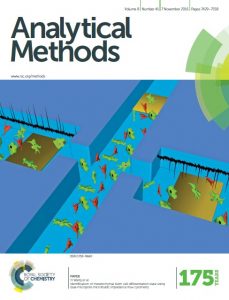 Huntsville, Ala. | November 28, 2016 – CFD Research Corporation researchers and partners are proud to have their publication on an innovative method to characterize stem cell differentiation featured on the cover of the 07 November 2016 issue of the Journal of Analytical Methods.
Huntsville, Ala. | November 28, 2016 – CFD Research Corporation researchers and partners are proud to have their publication on an innovative method to characterize stem cell differentiation featured on the cover of the 07 November 2016 issue of the Journal of Analytical Methods.
Regenerative therapies utilizing mesenchymal stem cells (MSCs) have grown dramatically over the past decade as MSCs possess multi-lineage differentiation potential, and have been differentiated into three principal lineages: bone, adipose, and cartilage. More recent studies have demonstrated MSC differentiation into cardiomyocyte, endothelial, and neural lineages. Furthermore, MSCs can be readily isolated from bone marrow and adipose tissue, making them an attractive source for autologous regenerative stem cell therapies such as bone grafts, wound healing, and myocardial repair following infarction, among other applications.
In order to develop more clinically relevant MSC-based therapies, the quality of MSCs and their progeny must be continuously monitored and assessed during the differentiation process. However, current biochemical assays used for monitoring stem cell differentiation, such as reverse transcription-polymerase chain reaction (RT-PCR), quantitative PCR (qPCR), and microarrays, are time consuming and invasive (i.e., alter the sample).
“The emergence of non-invasive stem cell-monitoring technologies is vital to the development of clinically feasible regenerative therapies and represents a paradigm shift for producing label-free, high-quality and well-characterized cells for immediate clinical use without the need for further purifications,” said Dr. Yi Wang, CFDRC director and the corresponding author.
In the featured paper, the authors demonstrated a label-free dual-micropore microfluidic impedance flow cytometry (MIFC) device in conjunction with a robust support vector machine (SVM)-based classification model for non-invasive determination of the differentiation state of mesenchymal stem cells (MSCs). Identification of human mesenchymal stem cells (hMSCs) and hMSC-derived osteoblasts in a mixed sample were successfully achieved with an accuracy of 87%. The results also convincingly show a progressive increase in the number of osteoblasts throughout the 21 day differentiation process.
“The microfluidic impedance flow cytometer system offers the promise to become an important non-invasive tool for assessing stem cell quality and differentiation stages for future regenerative medicine applications,” remarked Dr. Kapil Pant, CFDRC vice president.
Publication: “Identification of mesenchymal stem cell differentiation state using dual-micropore microfluidic impedance flow cytometry.” H. Song et.al. Anal. Methods, 2016, 8, 7437, DOI: 10.1039/C6AY01377E
About CFD Research Corporation: Since its inception in 1987, CFDRC has worked with government agencies, businesses and academia to provide innovative solutions within the Aerospace & Defense, Biomedical & Life Sciences, and Energy & Materials industries. Over the years CFDRC has earned multiple national awards for successful application and commercialization of innovative component/system technology prototypes, multi-physics simulation software and multi-disciplinary analyses. Learn more at www.cfdrc.com.
Contact:
Richard Thoms
Manger, Technology Partnerships
richard.thoms@cfdrc.com // 256.726.4810






